One missed call can cost you a client.
As business operations become more connected, even one missed or dropped call can mean a lost opportunity. It can slow down your team, frustrate customers, or even cost you a deal.
You are taking a big risk if your entire phone system depends on just one PBX VoIP provider. One issue with that provider, and everything goes down with it.
As your business expands, you might start noticing issues like call delays, poor quality in some regions, missing features, or pricing that no longer fits. These are common signs that a single VoIP provider may not be enough.
The reality is apparent: what worked for a small, centralized team doesn’t always support a growing, distributed operation.
Many businesses are turning to multi-provider setups, strategically using two or more PBX VoIP services to improve reliability, control costs, and tailor communications by region or department.
In this blog, we’ll explain how to manage multiple PBX VoIP service providers effectively, covering the advantages, risks, and technical considerations that make this model worth considering.
What It Means to Use Multiple PBX VoIP Providers
Using multiple PBX VoIP providers means a business relies on more than one VoIP service to handle different parts of its phone system. One provider might manage internal calls, while another handles outbound calls or provides backup during outages. Some companies also use separate providers for different regions or departments.
-
Multinational Companies in Different Time Zones
Global companies often work across various time zones. They may choose different VoIP providers in each region to ensure better call quality, lower costs, and local support.
For example, a company with offices in the U.S. and Europe might use one provider for North America and another for Europe to reduce call latency and access local features.
-
Separate Customer Support and Internal Calls
Some businesses want to keep customer support and internal communication on different systems. This helps manage traffic, track usage, and avoid service conflicts.
A company might use one provider with call center tools for customer support, while using a simpler service for internal calls between employees.
-
Access to Unique Features from Different Providers
No single provider offers every feature a business may need. One provider may have better voicemail-to-email services, while another offers strong international calling options. By combining services, companies can access the exact features they need without compromise.
What Makes Businesses Choose More Than One VoIP Service
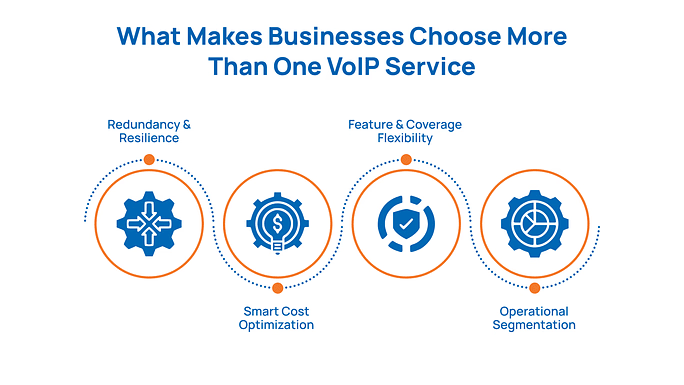 Many companies choose multiple providers to improve reliability, save money, or get better features across regions and teams. Here’s why more businesses are starting to choose this strategy:
Using more than one PBX or VoIP provider helps businesses stay connected during outages. If one provider fails due to issues like data center problems or internet disruptions, another can take over call handling. This setup reduces downtime and ensures that essential communication continues.
While most providers offer Service Level Agreements (SLAs) that promise high uptime, real-world situations can still lead to unexpected failures. A multi-provider strategy provides a practical backup in these situations.
Each VoIP provider has its pricing model. Businesses that use multiple providers can compare rates and choose the most cost-effective option for different types of calls.
For example, one provider may offer lower international rates while another has better local call pricing. Having more than one provider also gives businesses leverage during contract negotiations. They can compare features, terms, and pricing to make informed decisions and avoid long-term commitments to expensive plans.
Many companies choose multiple providers to improve reliability, save money, or get better features across regions and teams. Here’s why more businesses are starting to choose this strategy:
Using more than one PBX or VoIP provider helps businesses stay connected during outages. If one provider fails due to issues like data center problems or internet disruptions, another can take over call handling. This setup reduces downtime and ensures that essential communication continues.
While most providers offer Service Level Agreements (SLAs) that promise high uptime, real-world situations can still lead to unexpected failures. A multi-provider strategy provides a practical backup in these situations.
Each VoIP provider has its pricing model. Businesses that use multiple providers can compare rates and choose the most cost-effective option for different types of calls.
For example, one provider may offer lower international rates while another has better local call pricing. Having more than one provider also gives businesses leverage during contract negotiations. They can compare features, terms, and pricing to make informed decisions and avoid long-term commitments to expensive plans.
-
Feature & Coverage Flexibility
Not all providers offer the same features. Some may have better auto-attendant systems, while others offer stronger call analytics or voicemail options. By combining providers, businesses can use the best feature set available from each one.
This flexibility also allows them to route specific call types through providers that offer better quality or pricing. For example, international calls can go through a provider known for strong overseas connections, while domestic calls can be handled locally.
Businesses often divide operations across teams, departments, or regions. Using different VoIP providers for each segment allows better control and tracking. For instance, the support team can use one provider while the sales team uses another that is tailored to their call volume and features.
This segmentation also helps isolate issues, manage costs per department, and maintain separate settings or dashboards without overlap.
Benefits of Choosing Multiple PBX VoIP Providers for Your Business
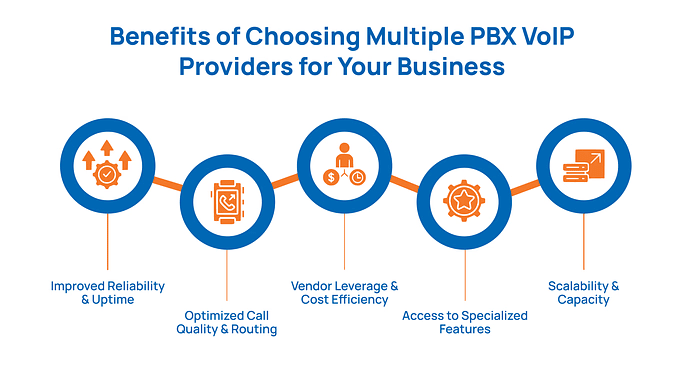 Here’s what your business can gain by using multiple PBX VoIP services.
Here’s what your business can gain by using multiple PBX VoIP services.
-
Improved Reliability & Uptime
Using more than one provider reduces the risk of total service failure. Calls can be routed through another provider if one system goes down due to a server issue or outage.
This setup helps maintain operations during technical problems. Having backup providers in different regions ensures continuous service for global businesses.
-
Optimized Call Quality & Routing
Different providers offer varying call quality based on location and routing. Businesses can direct calls through the provider with the best quality for each region or call type.
For example, one provider may perform better for international calls, while another works best for local numbers. This setup helps avoid issues like dropped calls or voice delays. It also allows businesses to reduce costs by routing calls through the most affordable provider.
-
Vendor Leverage & Cost Efficiency
Having multiple providers creates competition. Businesses can compare prices, terms, and features before signing any agreement.
This often leads to better deals and lower prices. It also reduces the cost of switching providers. Instead of fully migrating, companies can move only parts of their service if needed.
-
Access to Specialized Features
No single provider offers every feature. By combining services, businesses can use the best features from each one. For example, one provider may offer AI-powered call routing or transcription, while another has stronger CRM integrations.
This allows companies to tailor their communication systems to meet exact needs without compromising. TechRadar and TWC-IT Solution reports show that businesses using hybrid systems experience better productivity and call handling.
As a company grows, it needs more phone lines, extensions, or call center capacity. Multiple providers can support this growth without delays. If one provider reaches capacity, the company can simply route new calls through another. This avoids bottlenecks during busy periods.
Potential Drawbacks of Choosing Multiple PBX VoIP Providers for Your Business
While using multiple PBX VoIP providers has benefits, it also comes with challenges that businesses should consider before making the switch. Here are the challenges companies need to be aware of.
-
Complex Management Environment
Managing more than one PBX or VoIP provider adds complexity. Each platform has its dashboard, settings, and tools. Teams must monitor call quality, system logs, and usage reports separately.
This increases the chances of inconsistent user experiences. Depending on their provider, some users may have access to advanced features while others may not.
-
Higher Operational Overhead
Every provider has its own contract, billing process, and account management tasks. The finance and IT teams must track multiple invoices and vendor agreements, which increases the administrative burden.
-
Integration & Interoperability Issues
VoIP systems rely on technical standards like SIP protocols, codecs, and firewall configurations. Different providers may use other versions or settings. This can create issues when connecting one system to another.
Latency, jitter, and packet loss can also vary between providers. If not managed well, it may lead to dropped calls or poor voice quality. Network delays over 30 ms or packet loss above 1 % can significantly degrade sound clarity and lead to dropped conversations.
Every new provider adds more points that hackers can target. The average cost of a security breach in the U.S. reached $9.4 million, highlighting how costly an attack can be. Each additional provider increases the number of entry points into your communication system. This means a larger attack surface for cyber threats.
Security protocols like TLS encryption, fraud detection systems, and software patching vary from one provider to another. A gap in one provider’s system could expose the entire network.
When something goes wrong, pinpointing the problem can be difficult. One provider may blame another, leading to delayed resolutions. This “ping-pong” effect is common when dealing with multiple vendors.
It also slows down root-cause analysis. Without a single point of accountability, support tickets can take longer to resolve, especially in high-priority situations.
How Can You Balance Cost and Complexity with Multiple VoIP Providers?
Before using multiple PBX VoIP providers, it’s essential to understand the technical setup and financial impact. Here are a few considerations that you should consider:
-
Billing Structures & Hidden Costs
Different VoIP providers use different billing models. Some charge a flat fee per user, while others charge based on call usage. Businesses must compare these models to avoid overspending. A usage-based plan may seem cheaper, but could cost more if the call volume is high.
You should also look for hidden fees. These include number porting charges, setup fees, and emergency service (E911) fees. These costs can add up, especially when managing multiple vendors.
When using more than one provider, the systems must work together. This often involves configuring SIP trunks and defining call routing rules. Poor routing logic can cause delays or failed calls.
Businesses may need Session Border Controllers (SBCs) to control traffic between systems. SBCs help manage call flows, enforce security policies, and handle failovers if one provider goes down.
VoIP call quality depends on internet stability. Packet loss, jitter, or latency can make calls sound distorted or cause them to drop. When using multiple providers, quality can vary between them.
Businesses should plan for ISP redundancy or use MPLS lines to reduce the risk of connection issues. Monitoring tools can also help track and fix quality problems before they impact users.
VoIP systems must be secure, especially when multiple providers are involved. All communication should be encrypted using SRTP for media and TLS for signaling. Without encryption, data can be intercepted.
It’s also essential to use secure authentication methods to prevent unauthorized access. Businesses should monitor security across all vendor accounts to catch issues early. Centralized tools can help track logins, updates, and suspicious activity across platforms.
What to Consider Before Adopting a Multi-Provider VoIP Strategy
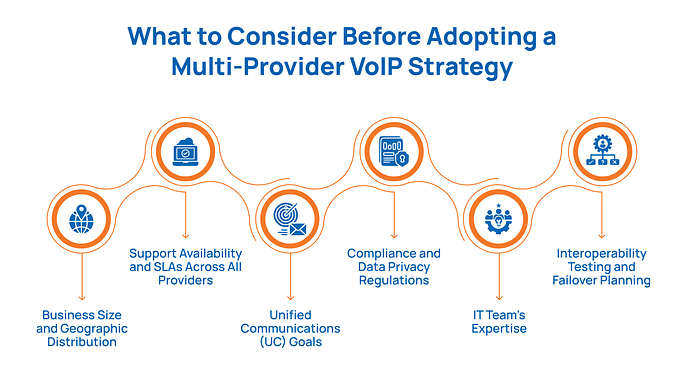 Here’s what your business should think through before deciding to work with multiple PBX VoIP providers.
Here’s what your business should think through before deciding to work with multiple PBX VoIP providers.
-
Business Size and Geographic Distribution
Larger companies or those with offices in multiple countries may benefit from using different providers based on location. A small business with one office might not need this complexity. It's essential to match the setup to the actual scale of operations.
-
Support Availability and SLAs Across All Providers
Each provider should offer consistent and reliable support. Check their support hours, channels (phone, email, live chat), and response times. Review their Service Level Agreements (SLAs) to understand uptime guarantees and how they handle service disruptions.
-
Unified Communications (UC) Goals
If your business wants to combine calling, video meetings, and messaging in one platform, not all VoIP providers will support that. Choose providers that align with your communication needs. Using multiple services may make it harder to unify tools if they don’t integrate well.
-
Compliance and Data Privacy Regulations
If you operate in regions like the EU or the U.S., your providers must follow laws such as GDPR or HIPAA. Check where their servers are located and how they handle data. Using multiple providers in different countries may increase legal and compliance risks.
Managing multiple VoIP systems requires technical skills. Your IT team should be able to configure SIP trunks, set up firewalls, manage quality of service (QoS), and handle security across platforms. If they don’t have this experience, consider sticking with one provider.
-
Interoperability Testing and Failover Planning
Before finalizing providers, test how well they work together. Make sure calls can pass between systems without delays or errors. Also, set up a clear failover plan so calls automatically switch to a backup provider if the main one fails.
When Should You Use More Than One PBX VoIP Provider?
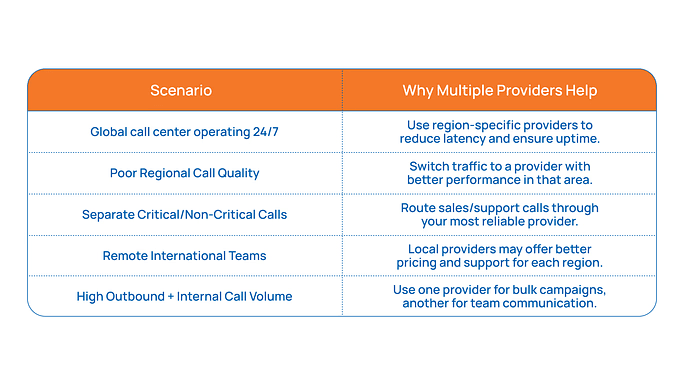
Best Practices for Multi-Provider VoIP Setups
Below are best practice strategies for managing multiple PBX VoIP service providers while controlling performance, security, and costs.
-
Unified Management Platform
Managing multiple VoIP systems can be difficult without a central interface. A VoIP aggregator or a communications platform as a service (CPaaS) can be used to control all providers in one place.
According to Forbes, CPaaS platforms consolidate voice, video, messaging, and other communications into one system. These platforms offer tools to manage call routing, user access, and reporting.
-
Clear Quantity-Based Contracts
Negotiate contracts that reflect your actual usage. Choose tiered pricing based on the number of users, call minutes, or lines. This gives you better pricing flexibility. Always include SLA terms in writing to ensure guaranteed uptime and support.
-
Integrated Quality & Security Policies
Standardize security and quality controls across all providers. Use consistent rules for encryption, authentication, and call monitoring. This reduces the chance of gaps or weak spots in your communication system.
Set up a central dashboard to monitor performance and security alerts across platforms. Real-time alerts help identify and fix issues faster.
-
Regular Audits & Provider Reviews
Track each provider's performance. Measure uptime, support response time, call quality, and cost. Review this data every quarter or year. Regular reviews help you stay ahead of problems and adjust the mix of providers as needed.
-
Run Periodic Failover Tests
A failover setup is only helpful if it works during a failure. Test it regularly to ensure calls reroute correctly when one provider goes down. Simulate different failure scenarios, such as ISP outages or server downtime.
Transition & Maintenance Tips for Multi-Provider VoIP Setups
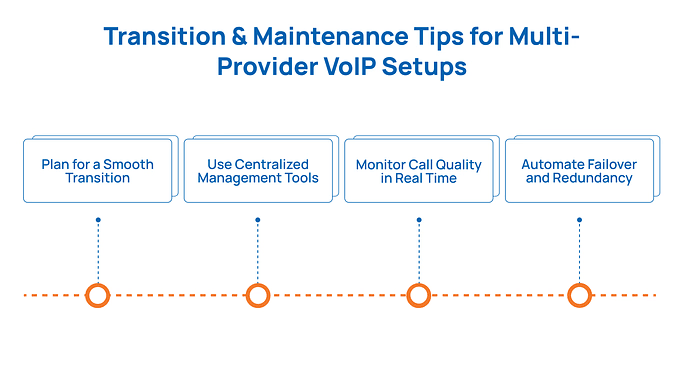 Once you’ve decided to use multiple VoIP providers, planning the transition carefully and keeping everything running smoothly is essential. Here’s how you can achieve this:
Once you’ve decided to use multiple VoIP providers, planning the transition carefully and keeping everything running smoothly is essential. Here’s how you can achieve this:
-
Plan for a Smooth Transition
Before switching or adding providers, set up the new system in parallel with your current one. Test all features such as call forwarding, voicemail, and integrations before moving any users. Schedule number porting carefully to avoid downtime. Always have a rollback option in case the new setup fails.
-
Use Centralized Management Tools
Managing more than one provider manually is time-consuming. Use tools like CPaaS platforms or VoIP dashboards to control routing, billing, and user access from one place. This simplifies daily operations and reduces errors.
-
Monitor Call Quality in Real Time
Call quality can vary between providers. Use monitoring software to track jitter, packet loss, and latency. Set alerts for performance drops and regularly review quality reports. This helps you catch and fix issues early.
-
Automate Failover and Redundancy
Set up automatic failover so calls are rerouted if one provider fails. Use Session Border Controllers (SBCs) or programmable routing tools to make the switch easy. Test failover systems regularly to ensure they work when needed.
Drive Better Conversations and Smoother Operations with PerfectSoft.AI
 At PerfectSoft.AI, we deliver intelligent, high-performance contact center solutions to improve customer satisfaction, boost agent productivity, and streamline operations.
Whether you manage a large-scale BPO, a customer service department, or an outbound sales team, our technology helps you stay connected across all channels while ensuring crystal-clear
We provide advanced VoIP-based Telecom Voice Services that guarantee:
At PerfectSoft.AI, we deliver intelligent, high-performance contact center solutions to improve customer satisfaction, boost agent productivity, and streamline operations.
Whether you manage a large-scale BPO, a customer service department, or an outbound sales team, our technology helps you stay connected across all channels while ensuring crystal-clear
We provide advanced VoIP-based Telecom Voice Services that guarantee:
- High-Quality Voice Calls – Clear and uninterrupted voice communication.
- Reliable Connectivity – Stable and secure connections across all regions.
- Global Reach – Seamless communication with teams and customers worldwide.
PerfectSoft.AI offers a well-integrated, cost-effective solution designed to grow with your business. Our platform integrates effortlessly with your existing CRM and business tools, ensuring smooth operations from day one. Easily scale your contact center as your needs evolve, all while enjoying personalized 24/7 support to keep everything running smoothly.
Your contact center deserves technology that keeps you ahead. Want clearer calls and fewer dropped connections?
PerfectSoft.AI can help.
Let’s Chat!
Frequently Asked Questions
1. How do I choose the right PBX VoIP provider?
Look at key factors like uptime (99.9% or higher is ideal), customer support quality, pricing structure, and how well the provider integrates with your current tools. Ask about hidden charges such as setup or porting fees. Try a trial period before signing a long-term contract. This helps you test performance and support before committing.
2. Will using multiple VoIP providers increase my overall costs?
It depends on how you structure the setup. While managing multiple vendors may involve separate contracts and admin tasks, it can also lower costs by letting you route calls through the most cost-effective provider. Careful planning and usage tracking are key to avoiding unnecessary expenses.
3. Can I switch to a new VoIP provider without losing service?
Yes, you can switch without interruption if you plan it carefully. Set up the new system while keeping the old one active. Test all features in advance. Use call forwarding or a dual setup during the switch to avoid missed calls. Make sure the number porting process is scheduled and confirmed ahead of time.
4. Do all VoIP providers support the same security features?
No. Security features like SRTP encryption, TLS signaling, and fraud detection vary between providers. Always review each vendor’s security protocols and ensure they meet your compliance requirements, especially if you operate in regulated industries.
3. What happens if two providers have overlapping features or tools?
Overlapping tools, like voicemail, call recording, or dashboards, can lead to confusion or wasted resources. Decide which provider handles which function and disable unused features to keep the setup clean and avoid duplicated costs.
 Many companies choose multiple providers to improve reliability, save money, or get better features across regions and teams. Here’s why more businesses are starting to choose this strategy:
Many companies choose multiple providers to improve reliability, save money, or get better features across regions and teams. Here’s why more businesses are starting to choose this strategy:
 Here’s what your business can gain by using multiple PBX VoIP services.
Here’s what your business can gain by using multiple PBX VoIP services.
 Here’s what your business should think through before deciding to work with multiple PBX VoIP providers.
Here’s what your business should think through before deciding to work with multiple PBX VoIP providers.

 Once you’ve decided to use multiple VoIP providers, planning the transition carefully and keeping everything running smoothly is essential. Here’s how you can achieve this:
Once you’ve decided to use multiple VoIP providers, planning the transition carefully and keeping everything running smoothly is essential. Here’s how you can achieve this:
 At PerfectSoft.AI, we deliver intelligent, high-performance contact center solutions to improve customer satisfaction, boost agent productivity, and streamline operations.
Whether you manage a large-scale BPO, a customer service department, or an outbound sales team, our technology helps you stay connected across all channels while ensuring crystal-clear
We provide advanced VoIP-based Telecom Voice Services that guarantee:
At PerfectSoft.AI, we deliver intelligent, high-performance contact center solutions to improve customer satisfaction, boost agent productivity, and streamline operations.
Whether you manage a large-scale BPO, a customer service department, or an outbound sales team, our technology helps you stay connected across all channels while ensuring crystal-clear
We provide advanced VoIP-based Telecom Voice Services that guarantee:


Comments